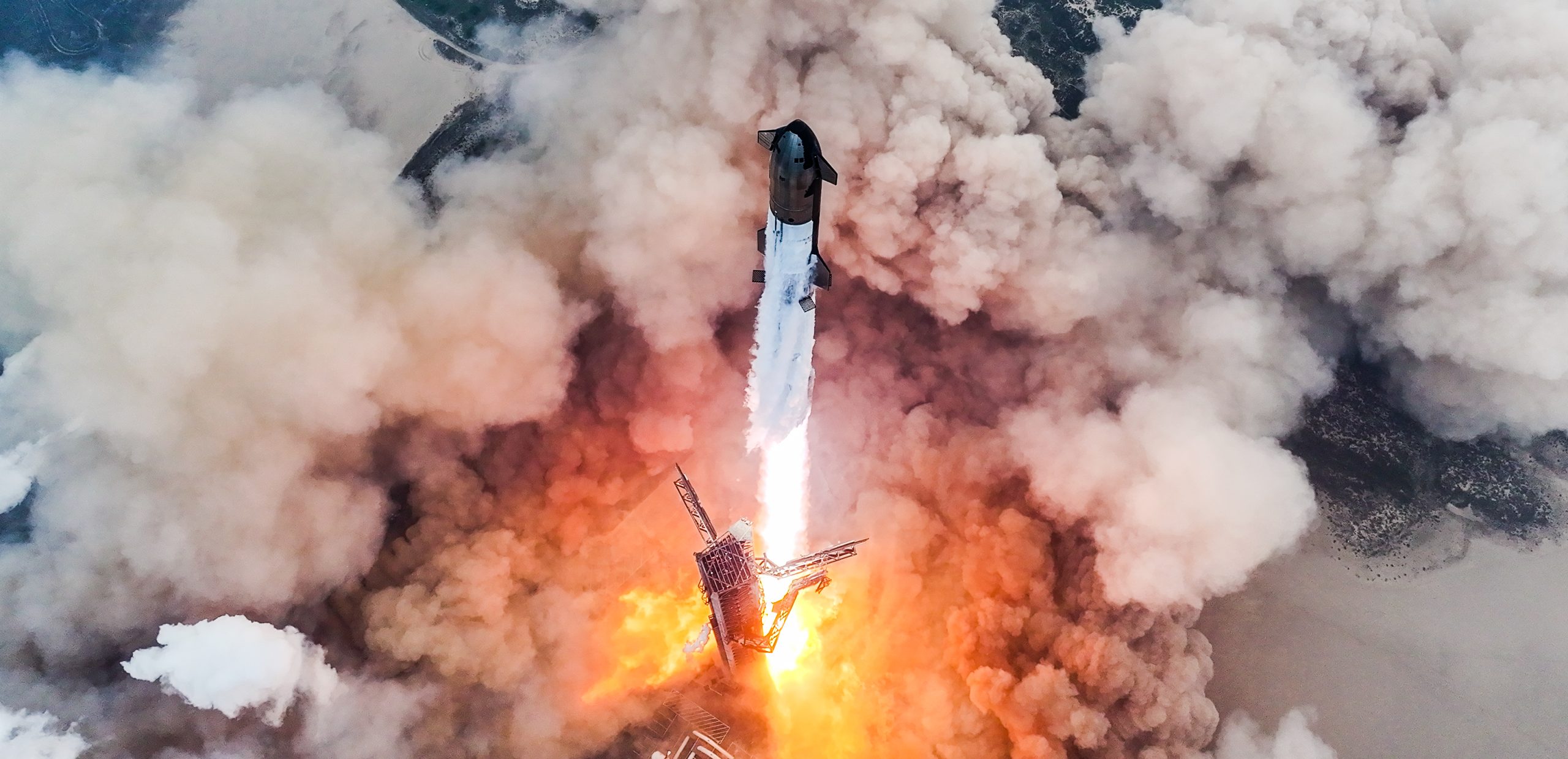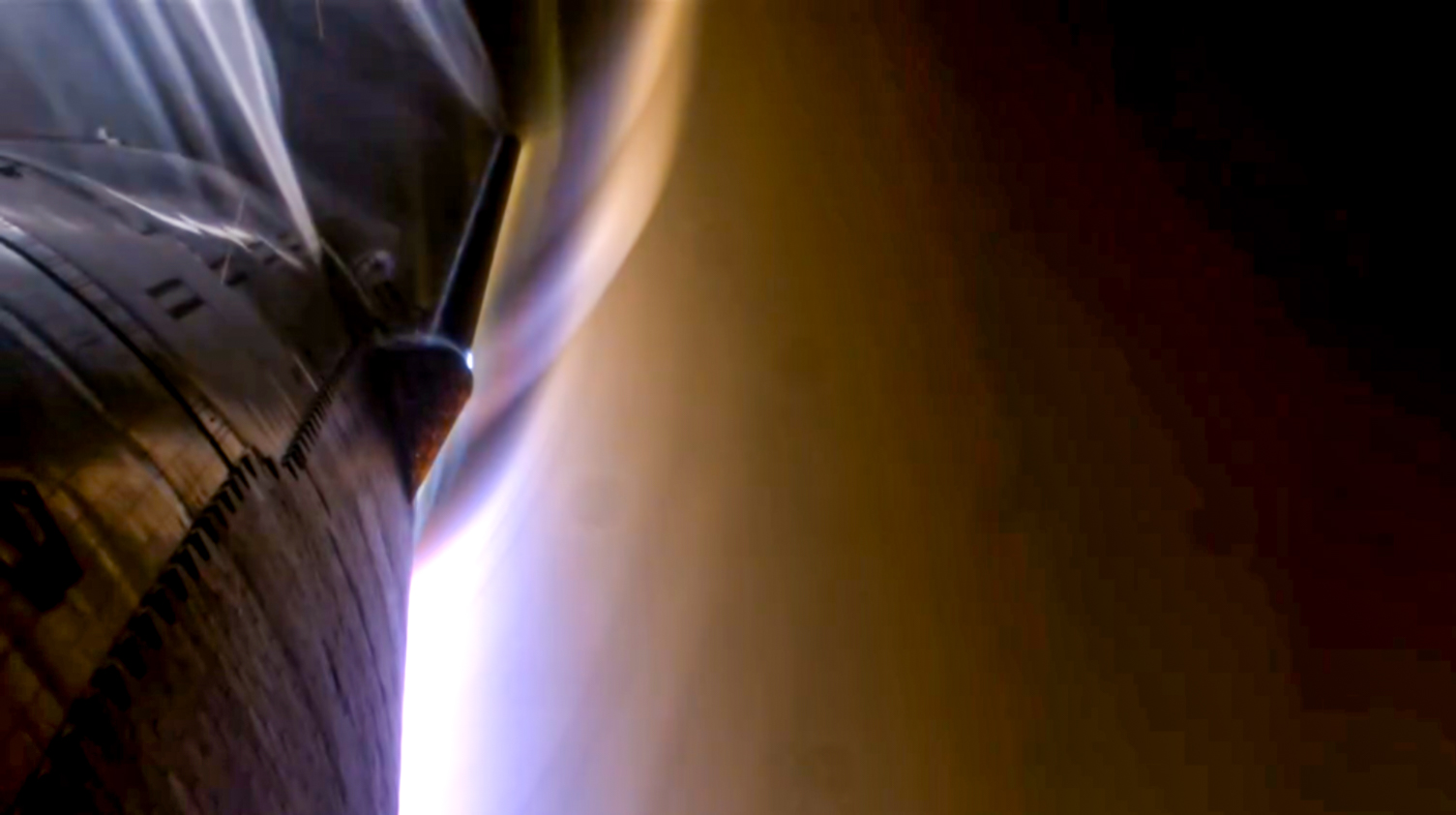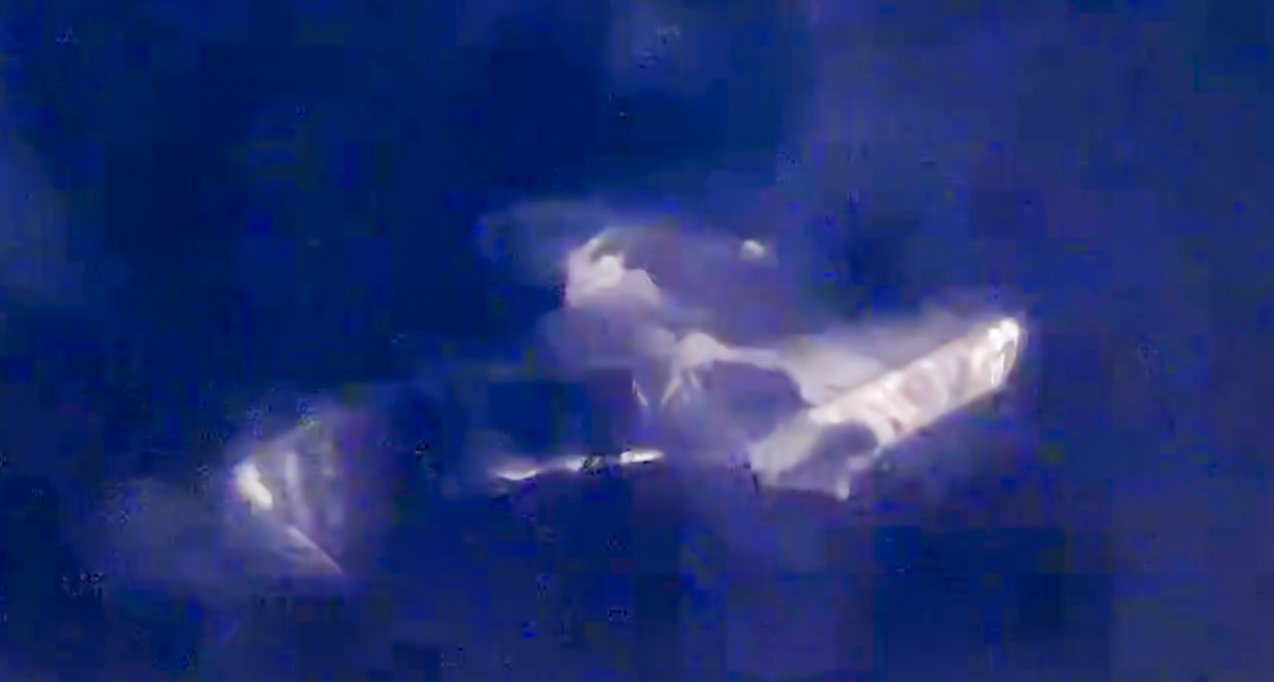

News
SpaceX aces fourth Starship flight test
SpaceX successfully launched and landed its Super Heavy booster and Starship on its fourth integrated flight test, with each making a soft splashdown in the water.
Starship took to the skies at 7:50 am CT from a foggy Starbase, Texas, in an effort to surpass previous flight milestones.
Liftoff of Starship! pic.twitter.com/2Z1PdNPYPG
— SpaceX (@SpaceX) June 6, 2024
As the countdown hit zero, 32 of 33 Raptor engines on the Super Heavy booster lit, with the outlier being an engine on the outer ring. Despite the engine out, the booster still ascended with ease away from the launch mount and broke through the thick fog into clear blue skies with views streamed back to the ground from just above one of the grid fins.
As Starship climbed, everything continued to operate nominally all the way through the hot staging which saw Super Heavy Booster 11 shut down all but its 3 center Raptor engines as Starship 29 lit its 6 Raptor engines to pull away from the massive booster. As soon as Starship was clear, Booster 11 completed a flip and boostback burn to begin its trip for a planned soft touchdown in the Gulf of Mexico by relighting 10 Raptor engines.
Once the boostback burn was complete, the hot staging ring was ejected to reduce the overall mass of the booster to help it survive reentry and landing. Future Super Heavy boosters will feature a lighter hot staging ring that will not be ejected. As the booster made its way back, it re-orientated to vertical and began re-entry back through the atmosphere, and unlike the Falcon 9, it does not perform an entry burn.
Hot stage jettison pic.twitter.com/J48QtQD1Ae
— SpaceX (@SpaceX) June 6, 2024
At around 7 minutes and 15 seconds into flight, the Super Heavy booster lit 12 out of a planned 13 engines for its landing burn, followed shortly by quite a bit of debris flying by the onboard camera, but it did not affect anything critical as seconds later Booster 11 made a successful splashdown in the Gulf of Mexico before a slow planned tip over into the water.
Super Heavy has splashed down in the Gulf of Mexico pic.twitter.com/hIY3Gkq57k
— SpaceX (@SpaceX) June 6, 2024
As Booster 11 completed the first successful soft landing, Starship 29 fired its six Raptor engines, three sea level and three vacuum, with engine shutoff coming in at eight and a half minutes into flight. The starship then entered a long coast phase as it passed between the Florida Keys and Cuba and transited over the Atlantic Ocean, followed by Africa.
During IFT-3, live views were provided for a majority of this portion but due to an unknown issue, cameras didn’t come back until just before 37 minutes into the flight. Elon Musk posted on X that they had a data signal the entire time including live views from internal cameras.
45 minutes into the flight, the true test of Starship began as plasma started to build up, but this time, Starship was in the correct orientation, and the heatshield was facing the correct way to give the ship its best chance at survival.
As Starship descended, plasma build-up increased with callouts from mission control noting rising temperatures on the nose but all within acceptable limits. At just over 54 minutes into the flight, Starship made it further than the third flight test and into unknown territory.
Plasma builds up as Starship re-enters the atmosphere (Credit SpaceX)
57 minutes into the flight, peak heating had passed but tiles were starting to fall away from the forward flap followed by melting of the lower portion, despite this damage, Starship held strong and in the correct orientation as it descended.
Starship continued its descent and, with significant damage, still made it through to its own landing burn and performed its flip to a vertical orientation and a soft touchdown in the Indian Ocean west of Australia.
Damage to the forward flap as seen during the landing burn (Credit SpaceX)
Even with the damage inflicted on Starship, it completed all test objectives while providing SpaceX with incredibly valuable data that will be used to make the ship stronger on future test flights. The Starlink antenna also survived the entire flight which ensured this data made it back to mission control.
With this successful mission complete, SpaceX could launch the 5th flight by mid to late July and possibly even attempt a catch of the Super Heavy booster according to Elon Musk.
Catch a replay of this epic mission below!
Watch Starship’s fourth flight test → https://t.co/bJFjLCiTbK https://t.co/SjpjscHoUB
— SpaceX (@SpaceX) June 6, 2024
How do you think this flight went overall, and will the fifth flight take place by August?
Questions or comments? Shoot me an email at rangle@teslarati.com, or Tweet me @RDAnglePhoto.
News
Tesla cleared in Canada EV rebate investigation
Tesla has been cleared in an investigation into the company’s staggering number of EV rebate claims in Canada in January.

Canadian officials have cleared Tesla following an investigation into a large number of claims submitted to the country’s electric vehicle (EV) rebates earlier this year.
Transport Canada has ruled that there was no evidence of fraud after Tesla submitted 8,653 EV rebate claims for the country’s Incentives for Zero-Emission Vehicles (iZEV) program, as detailed in a report on Friday from The Globe and Mail. Despite the huge number of claims, Canadian authorities have found that the figure represented vehicles that had been delivered prior to the submission deadline for the program.
According to Transport Minister Chrystia Freeland, the claims “were determined to legitimately represent cars sold before January 12,” which was the final day for OEMs to submit these claims before the government suspended the program.
Upon initial reporting of the Tesla claims submitted in January, it was estimated that they were valued at around $43 million. In March, Freeland and Transport Canada opened the investigation into Tesla, noting that they would be freezing the rebate payments until the claims were found to be valid.
READ MORE ON ELECTRIC VEHICLES: EVs getting cleaner more quickly than expected in Europe: study
Huw Williams, Canadian Automobile Dealers Association Public Affairs Director, accepted the results of the investigation, while also questioning how Tesla knew to submit the claims that weekend, just before the program ran out.
“I think there’s a larger question as to how Tesla knew to run those through on that weekend,” Williams said. “It doesn’t appear to me that we have an investigation into any communication between Transport Canada and Tesla, between officials who may have shared information inappropriately.”
Tesla sales have been down in Canada for the first half of this year, amidst turmoil between the country and the Trump administration’s tariffs. Although Elon Musk has since stepped back from his role with the administration, a number of companies and officials in Canada were calling for a boycott of Tesla’s vehicles earlier this year, due in part to his association with Trump.
News
Tesla Semis to get 18 new Megachargers at this PepsiCo plant
PepsiCo is set to add more Tesla Semi Megachargers, this time at a facility in North Carolina.

Tesla partner PepsiCo is set to build new Semi charging stations at one of its manufacturing sites, as revealed in new permitting plans shared this week.
On Friday, Tesla charging station scout MarcoRP shared plans on X for 18 Semi Megacharging stalls at PepsiCo’s facility in Charlotte, North Carolina, coming as the latest update plans for the company’s increasingly electrified fleet. The stalls are set to be built side by side, along with three Tesla Megapack grid-scale battery systems.
The plans also note the faster charging speeds for the chargers, which can charge the Class 8 Semi at speeds of up to 1MW. Tesla says that the speed can charge the Semi back to roughly 70 percent in around 30 minutes.
You can see the site plans for the PepsiCo North Carolina Megacharger below.

Credit: PepsiCo (via MarcoRPi1 on X)

Credit: PepsiCo (via MarcoRPi1 on X)
READ MORE ON THE TESLA SEMI: Tesla to build Semi Megacharger station in Southern California
PepsiCo’s Tesla Semi fleet, other Megachargers, and initial tests and deliveries
PepsiCo was the first external customer to take delivery of Tesla’s Semis back in 2023, starting with just an initial order of 15. Since then, the company has continued to expand the fleet, recently taking delivery of an additional 50 units in California. The PepsiCo fleet was up to around 86 units as of last year, according to statements from Semi Senior Manager Dan Priestley.
Additionally, the company has similar Megachargers at its facilities in Modesto, Sacramento, and Fresno, California, and Tesla also submitted plans for approval to build 12 new Megacharging stalls in Los Angeles County.
Over the past couple of years, Tesla has also been delivering the electric Class 8 units to a number of other companies for pilot programs, and Priestley shared some results from PepsiCo’s initial Semi tests last year. Notably, the executive spoke with a handful of PepsiCo workers who said they really liked the Semi and wouldn’t plan on going back to diesel trucks.
The company is also nearing completion of a higher-volume Semi plant at its Gigafactory in Nevada, which is expected to eventually have an annual production capacity of 50,000 Semi units.
Tesla executive teases plan to further electrify supply chain
News
Tesla sales soar in Norway with new Model Y leading the charge
Tesla recorded a 54% year-over-year jump in new vehicle registrations in June.

Tesla is seeing strong momentum in Norway, with sales of the new Model Y helping the company maintain dominance in one of the world’s most electric vehicle-friendly markets.
Model Y upgrades and consumer preferences
According to the Norwegian Road Federation (OFV), Tesla recorded a 54% year-over-year jump in new vehicle registrations in June. The Model Y led the charge, posting a 115% increase compared to the same period last year. Tesla Norway’s growth was even more notable in May, with sales surging a whopping 213%, as noted in a CNBC report.
Christina Bu, secretary general of the Norwegian EV Association (NEVA), stated that Tesla’s strong market performance was partly due to the updated Model Y, which is really just a good car, period.
“I think it just has to do with the fact that they deliver a car which has quite a lot of value for money and is what Norwegians need. What Norwegians need, a large luggage space, all wheel drive, and a tow hitch, high ground clearance as well. In addition, quite good digital solutions which people have gotten used to, and also a charging network,” she said.
Tesla in Europe
Tesla’s success in Norway is supported by long-standing government incentives for EV adoption, including exemptions from VAT, road toll discounts, and access to bus lanes. Public and home charging infrastructure is also widely available, making the EV ownership experience in the country very convenient.
Tesla’s performance in Europe is still a mixed bag, with markets like Germany and France still seeing declines in recent months. In areas such as Norway, Spain, and Portugal, however, Tesla’s new car registrations are rising. Spain’s sales rose 61% and Portugal’s sales rose 7% last month. This suggests that regional demand may be stabilizing or rebounding in pockets of Europe.
-

 Elon Musk2 weeks ago
Elon Musk2 weeks agoTesla investors will be shocked by Jim Cramer’s latest assessment
-

 Elon Musk2 days ago
Elon Musk2 days agoxAI launches Grok 4 with new $300/month SuperGrok Heavy subscription
-

 Elon Musk4 days ago
Elon Musk4 days agoElon Musk confirms Grok 4 launch on July 9 with livestream event
-

 News1 week ago
News1 week agoTesla Model 3 ranks as the safest new car in Europe for 2025, per Euro NCAP tests
-

 Elon Musk2 weeks ago
Elon Musk2 weeks agoA Tesla just delivered itself to a customer autonomously, Elon Musk confirms
-

 Elon Musk1 week ago
Elon Musk1 week agoxAI’s Memphis data center receives air permit despite community criticism
-

 News2 weeks ago
News2 weeks agoXiaomi CEO congratulates Tesla on first FSD delivery: “We have to continue learning!”
-

 News2 weeks ago
News2 weeks agoTesla sees explosive sales growth in UK, Spain, and Netherlands in June

















